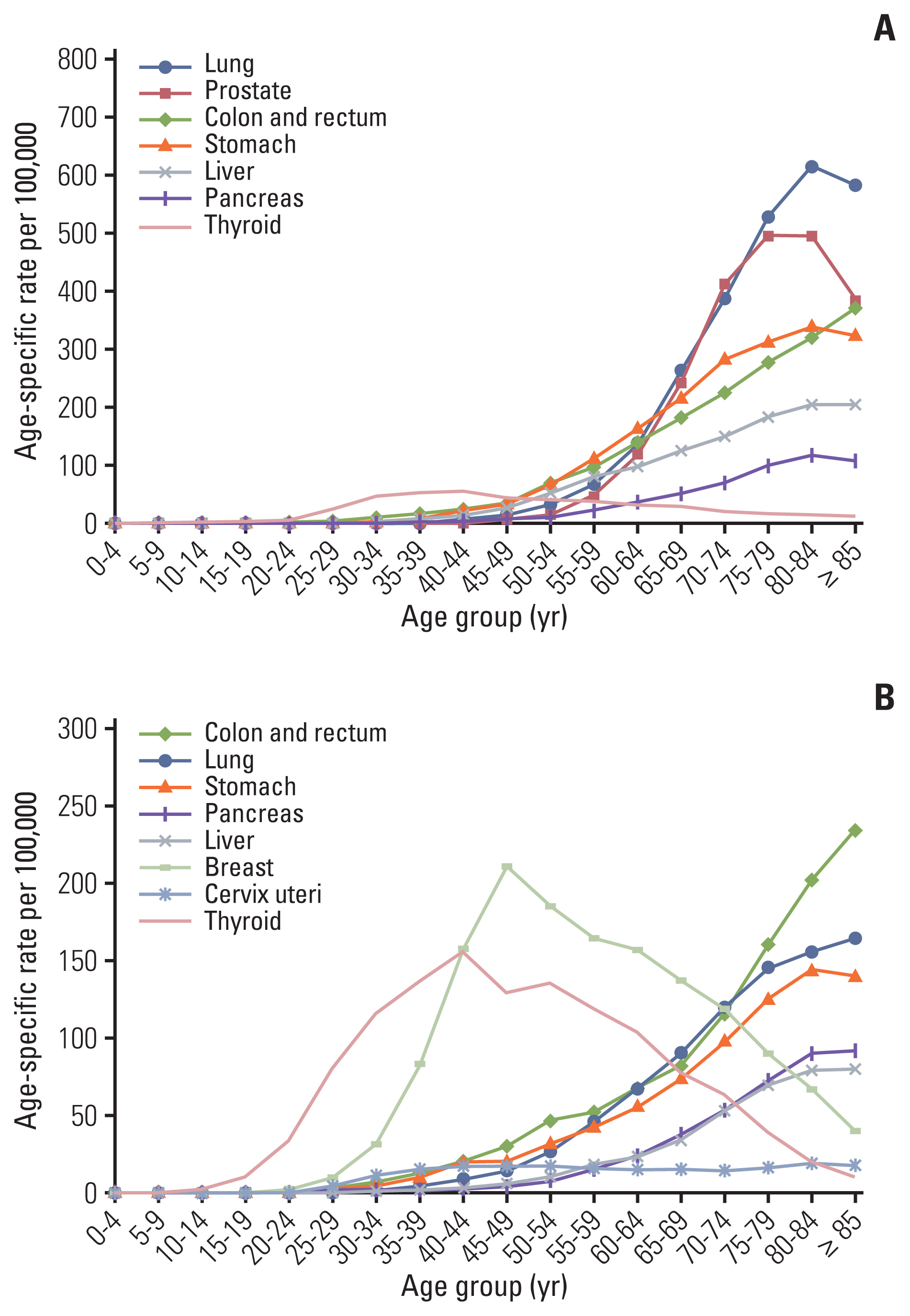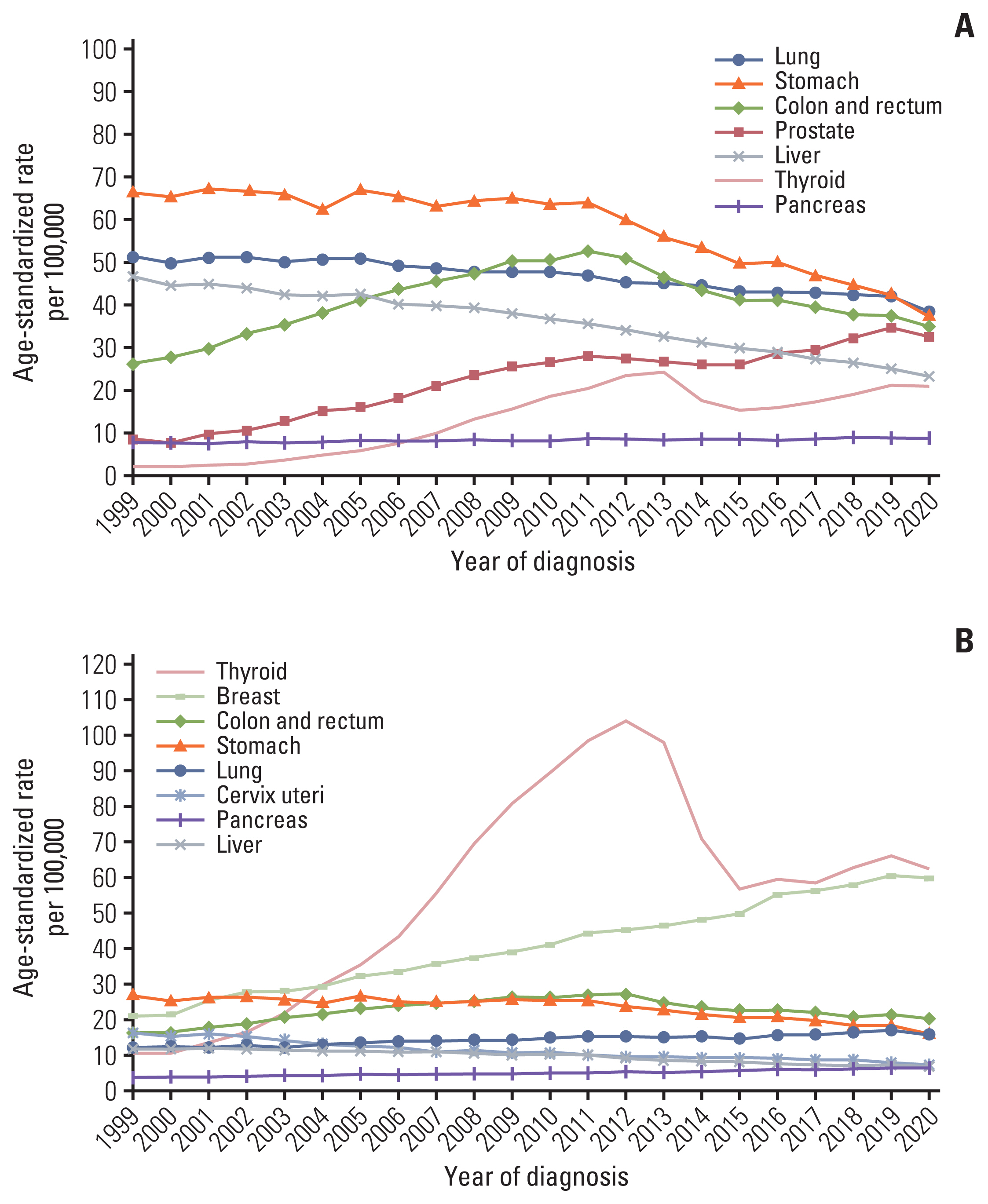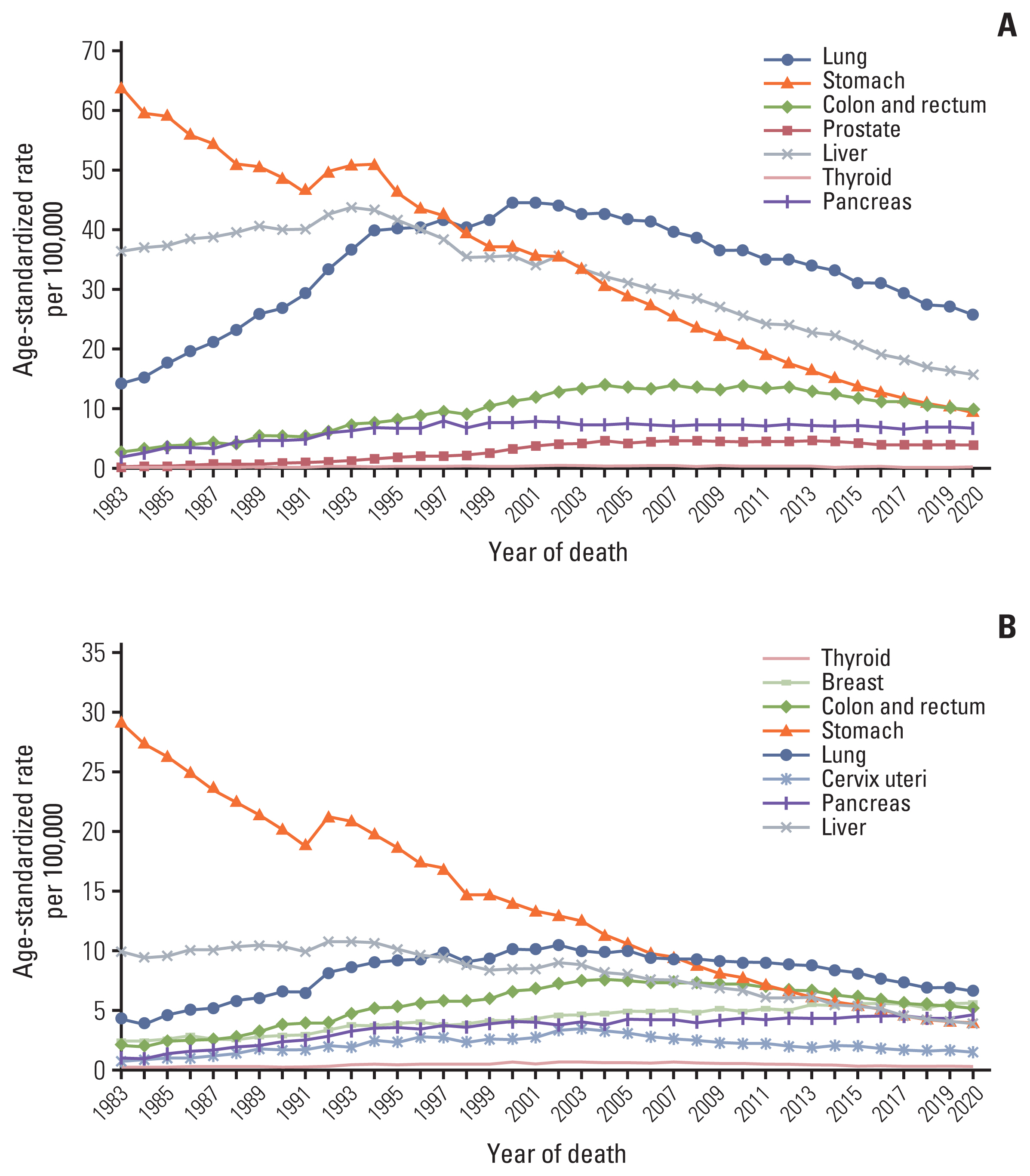Cancer Statistics in Korea: Incidence, Mortality, Survival, and Prevalence in 2020
- Affiliations
-
- 1Korea Central Cancer Registry, National Cancer Center, Goyang, Korea
- 2Division of Cancer Registration and Surveillance, National Cancer Control Institute, National Cancer Center, Goyang, Korea
- 3National Cancer Control Institute, National Cancer Center, Goyang, Korea
- 4National Cancer Center Graduate School of Cancer Science and Policy, National Cancer Center, Goyang, Korea
- KMID: 2541226
- DOI: http://doi.org/10.4143/crt.2023.447
Abstract
- Purpose
The current study provides national cancer statistics and their secular trends in Korea, including incidence, mortality, survival, and prevalence in 2020.
Materials and Methods
Incidence, survival, and prevalence rates of cancer were calculated using the Korea National Cancer Incidence Database, from 1999 to 2020, with survival follow-up until December 31, 2021. Deaths from cancer were assessed using causes-of-death data obtained from Statistics Korea.
Results
The number of new cancer diagnoses in 2020 decreased by 9,218 cases (3.6%) compared to 2019. In 2020, newly diagnosed cancer cases and deaths from cancer were reported as 247,952 (age-standardized rate [ASR], 262.2 per 100,000) and 82,204 (ASR, 69.9 per 100,000), respectively. The overall cancer incidence rates increased by 3.3% annually from 1999 to 2012, and decreased by 5.0% annually from 2012 to 2015, thereafter, followed by nonsignificant changes. Cancer mortality rates have been decreasing since 2002, with more rapid decline in recent years. The 5-year relative survival between 2016 and 2020 was 71.5%, which contributed to prevalent cases reaching over 2.2 million in 2020.
Conclusion
In 2020, the number of newly diagnosed cancer patients decreased due to the coronavirus disease 2019 pandemic, but the overall trend is on the rise. Cancer survival rates have improved over the past decades. As the number of cancer survivors increases, a comprehensive cancer control strategy should be implemented in line with the changing aspects of cancer statistics. The long-term impact of the coronavirus disease 2019 pandemic on cancer statistics needs to be investigated in the future.
Figure
Cited by 4 articles
-
Incidence and survival of gynecologic cancer including cervical, uterine, ovarian, vaginal, vulvar cancer and gestational trophoblastic neoplasia in Korea, 1999–2019: Korea Central Cancer Registry
Bo Seong Yun, Eun Hye Park, Johyun Ha, Jung-Yun Lee, Keun Ho Lee, Taek Sang Lee, Kyung Ju Lee, Young Ju Kim, Kyu-Won Jung, Ju-Won Roh
Obstet Gynecol Sci. 2023;66(6):545-561. doi: 10.5468/ogs.23208.Rare Neurological Complications in Thyroid Cancer Surgery
Joon Yong Park, Doh Young Lee
Int J Thyroidol. 2023;16(2):143-146. doi: 10.11106/ijt.2023.16.2.143.Surgical outcomes and survival of patients over 80 years old who underwent curative resection for gastric cancer
Seunghui Lee, Miyeong Lee, Sangdon Kwan, Soohyung Kim, Ki Bum Park, Oh Kyoung Kwon, Ji Yeon Park
Ann Surg Treat Res. 2023;105(6):376-384. doi: 10.4174/astr.2023.105.6.376.Advancing Korean nationwide registry for hepatocellular carcinoma: a systematic sampling approach utilizing the Korea Central Cancer Registry database
Bo Hyun Kim, E Hwa Yun, Jeong-Hoon Lee, Geun Hong, Jun Yong Park, Ju Hyun Shim, Eunyang Kim, Hyun-Joo Kong, Kyu-Won Jung, Young-Suk Lim
J Liver Cancer. 2024;24(1):57-61. doi: 10.17998/jlc.2024.03.03.
Reference
-
References
1. Ferlay J, Ervik M, Lam F, Colombet M, Mery L, Pineros M, et al. Global cancer observatory: cancer today [Internet]. Lyon: International Agency for Research on Cancer;2020. [cited 2023 Feb 6]. Available from: https://gco.iarc.fr/today.2. Statistics Korea [Internet]. Daejeon: Statistics Korea;2021. [cited 2023 Feb 6]. Available from: http://kosis.kr.3. Siegel RL, Miller KD, Fuchs HE, Jemal A. Cancer statistics, 2022. CA Cancer J Clin. 2022; 72:7–33.4. Lee K, Lee YY, Suh M, Jun JK, Park B, Kim Y, et al. Impact of COVID-19 on cancer screening in South Korea. Sci Rep. 2022; 12:11380.5. Teglia F, Angelini M, Astolfi L, Casolari G, Boffetta P. Global association of COVID-19 pandemic measures with cancer screening: a systematic review and meta-analysis. JAMA Oncol. 2022; 8:1287–93.6. Shin HR, Won YJ, Jung KW, Kong HJ, Yim SH, Lee JK, et al. Nationwide cancer incidence in Korea, 1999~2001; first result using the national cancer incidence database. Cancer Res Treat. 2005; 37:325–31.7. Ajiki W, Tsukuma H, Oshima A. Index for evaluating completeness of registration in population-based cancer registries and estimation of registration rate at the Osaka Cancer Registry between 1966 and 1992 using this index. Nihon Koshu Eisei Zasshi. 1998; 45:1011–7.8. Fritz A, Percy C, Jack A, Shanmugaratnam K, Sobin L, Parkin DM, et al. International classification of diseases for oncology. 3rd ed. 1st rev. Geneva: World Health Organization;2013.9. World Health Organization. International statistical classification of diseases and related health problems. 10th rev. . Geneva: World Health Organization;1994.10. Ferlay J, Ervik M, Lam F, Colombet M, Mery L, Pineros M, et al. Global cancer observatory: cancer today – data and methods [Internet]. Lyon: International Agency for Research on Cancer;2020. [cited 2023 Feb 6]. Available from: https://gco.iarc.fr/today/data-sources-methods.11. Cancer incidence in five continents, XI Chapter 3. Classification and coding [Internet]. Lyon: International Agency for Research on Cancer;2017. [cited 2023 Feb 6]. Available from: http://ci5.iarc.fr/CI5-XI/Pages/Chapter3.aspx.12. Young JL Jr, Roffers SD, Ries LA, Fritz AG, Hurlbut AA. SEER summary staging manual 2000: codes and coding instructions. National Cancer Institute, NIH Pub No. 01-4969. Bethesda, MD: National Cancer Institute;2001.13. Cancer incidence in five continents, XI Chapter 7. Age standardization [Internet]. Lyon: International Agency for Research on Cancer;2017. [cited 2023 Feb 6]. Available from: http://ci5.iarc.fr/CI5-XI/Pages/Chapter7.aspx.14. Segi M. Cancer mortality for selected sites in 24 countries 1950–1957. Sendai: Tohoku University School of Medicine;1960.15. Ederer F, Heise H. Instructions to IBM 650 programmers in processing survival computations. Methodological note, No 10. Bethesda, MD: National Cancer Institute;1959.16. Paul Dickman [Internet]. Stockholm: PaulDickman.com;2016. [cited 2023 Feb 6]. Available from: http://www.pauldickman.com.
- Full Text Links
- Actions
-
Cited
- CITED
-
- Close
- Share
- Similar articles
-
- Cancer Statistics in Korea: Incidence, Mortality, Survival, and Prevalence in 2008
- Cancer Statistics in Korea: Incidence, Mortality, Survival, andPrevalence in 2017
- Cancer Statistics in Korea: Incidence, Mortality, Survival, and Prevalence in 2016
- Cancer Statistics in Korea: Incidence, Mortality, Survival, and Prevalence in 2014
- Cancer Statistics in Korea: Incidence, Mortality, Survival, and Prevalence in 2015








